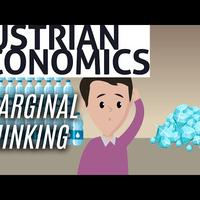Essential Austrian Economics: Marginal Thinking
Essential Austrian Economics: Marginale Denkweisen
Economía austriaca esencial: Pensamiento marginal
L'essentiel de l'économie autrichienne : La pensée marginale
"Essential Austrian Economics": Marginalus mąstymas.
Essential Austrian Economics: Marginal Thinking
Essential Austrian Economics: Pensamento Marginal
Essential Austrian Economics: Маргинальное мышление
Temel Avusturya İktisadı: Marjinal Düşünce
Основи австрійської економіки: Маржинальне мислення
基本奥地利经济学边际思维
One of the most important contributions of Carl Menger, the founder of the Austrian School,
Jeden z najważniejszych wkładów Carla Mengera, twórcy Szkoły Austriackiej,
Avusturya Okulu'nun kurucusu Carl Menger'in en önemli katkılarından biri,
was the development of what's known as marginal thinking.
was the development of what's known as marginal thinking.
marjinal düşünce olarak bilinen şeyin gelişimiydi.
був розвиток так званого маргінального мислення.
Menger, along with other economists working independently around Europe, solved a longstanding
Menger, wraz z innymi ekonomistami pracującymi niezależnie w całej Europie, rozwiązał długotrwały
Menger, Avrupa'da bağımsız olarak çalışan diğer ekonomistlerle birlikte, uzun süredir devam eden bir sorunu çözdü.
Менгер, разом з іншими економістами, які працювали незалежно по всій Європі, вирішив давню проблему
puzzle in economics: The Water-Diamond paradox. Why is water so inexpensive when it's necessary
zagadka w ekonomii: Paradoks wody-diamentu. Dlaczego woda jest tak tania, gdy jest niezbędna
for life, while diamonds, which have limited practical usefulness, are incredibly expensive?
Prior to marginal thinking, economists couldn't answer this question.
Przed myśleniem marginalnym ekonomiści nie potrafili odpowiedzieć na to pytanie.
Economists treated all decisions as if they are all-or-nothing,
Ekonomiści traktowali wszystkie decyzje tak, jakby były one all-or-nothing,
Економісти ставилися до всіх рішень так, ніби вони були "все або нічого",
meaning that we either have water or diamonds. But such an approach can't explain the low price
co oznacza, że albo mamy wodę, albo diamenty. Ale takie podejście nie może wyjaśnić niskiej ceny
що у нас є або вода, або алмази. Але такий підхід не може пояснити низьку ціну
of water and high price of diamonds. What Menger and others realized is
that people don't make decisions based on an all-or-nothing basis.
що люди не приймають рішення на основі принципу "все або нічого".
Instead, we decide to have a little bit more or a little bit less of something,
based on what we value more at the time. In other words, we make judgements about
what we value in terms of purchasing one more unit of a good or service—and
so, we value things at the margin. But marginal thinking also explains
więc cenimy rzeczy na marginesie. Ale myślenie marginalne wyjaśnia również
Отже, ми цінуємо речі на маргінесі. Але маргінальне мислення також пояснює
how the value people place on a good or service is influenced by scarcity.
The more abundant something is, like water which is very abundant, the less its perceived value
Чим більше чогось є, наприклад, води, якої дуже багато, тим меншою є її сприйнята цінність
compared to goods like diamonds, which are quite scarce, and therefore fetch much higher prices.
But now imagine you're hiking in the desert and you run out of water.
Ale teraz wyobraź sobie, że wędrujesz po pustyni i kończy ci się woda.
Ama şimdi çölde yürüyüş yaptığınızı ve suyunuz bittiğini hayal edin.
Suddenly the normally abundant water is now incredibly scarce and its value to you—
as you become more thirsty in the hot desert-- probably now exceeds what you'd pay for a diamond.
w miarę jak stajesz się bardziej spragniony na gorącej pustyni - prawdopodobnie teraz przekracza to, co zapłaciłby pan za diament.
This marginal way of thinking not only solved the water-diamond paradox but explained how people
Цей маргінальний спосіб мислення не лише вирішив парадокс води і алмазу, але й пояснив, як люди
actually make decisions in their lives. The development of marginal analysis
revolutionized economics and continues to influence the way we think about the world today.

